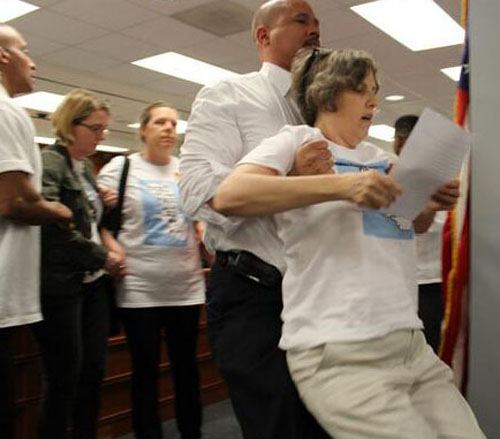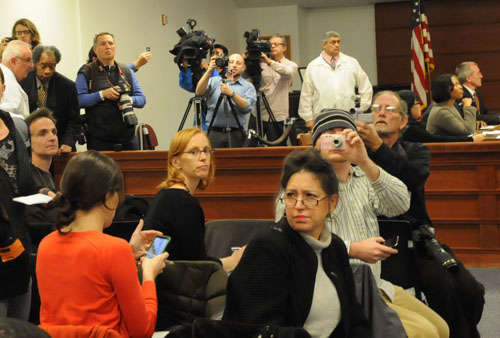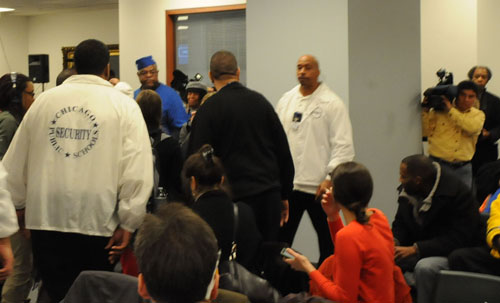MEDIA WATCH: Chicago Sun-Times fires photographers... Reporters to be required to do double-duty
Less than two weeks after a Sun-Times photograph captured the police state reality at the monthly meetings of the Chicago Board of Education, depicting parent Erica Clark being dragged from the May 22 meeting of the Board, the Sun-Times, owned by friends of Rahm Emanuel, is getting rid of all its photographers. According to news reports, reporters will now double as photographers.
 Anyone who believes that news stories can be adequately reported by words alone should consider the story from the recent meeting of the Chicago Board of Education. All Erica Clark (above, being dragged away from the meeting) did was try and read the names of all the schools slated for closing during the public participation portion of the meeting. When she continued reading after her "time" was called, CPS security guards carried her out of the meeting. Clark's reading of all the names on the 2013 Hit List was the only time they were read. When the six members of the Chicago Board of Education voted an hour after the above incident to close the schools, they didn't even read the names, only the 'Board Report' numbers before they voted to destroy the schools. Photo above by DNAinfo Chicago.Although I have covered school news for more than 30 years in Chicago, at many events I have served as Substance photographer while others have been our reporters. We learned over and over that the jobs are distinct, because the photographer has to be ready to respond to a visual event -- such as the December 14, 2011 "Mic Check" at the Board meeting -- and the reporter is supposed to be getting all the facts down for the reporting. You cannot do both when the explosions take place. Everyone who knows reporting knows those facts.
Anyone who believes that news stories can be adequately reported by words alone should consider the story from the recent meeting of the Chicago Board of Education. All Erica Clark (above, being dragged away from the meeting) did was try and read the names of all the schools slated for closing during the public participation portion of the meeting. When she continued reading after her "time" was called, CPS security guards carried her out of the meeting. Clark's reading of all the names on the 2013 Hit List was the only time they were read. When the six members of the Chicago Board of Education voted an hour after the above incident to close the schools, they didn't even read the names, only the 'Board Report' numbers before they voted to destroy the schools. Photo above by DNAinfo Chicago.Although I have covered school news for more than 30 years in Chicago, at many events I have served as Substance photographer while others have been our reporters. We learned over and over that the jobs are distinct, because the photographer has to be ready to respond to a visual event -- such as the December 14, 2011 "Mic Check" at the Board meeting -- and the reporter is supposed to be getting all the facts down for the reporting. You cannot do both when the explosions take place. Everyone who knows reporting knows those facts.
One of the sentences that jumped out for me in reading the Crain's Chicago Business report on the Sun-Times attack on reporting was the following: "Among those cut was Pulitzer Prize-winning photographer John White, who won the award in 1982 for his consistently outstanding work..." Whenever John White was covering a CPS event, a reporter or photographer could get a lesson in the business by watching how he moved around a story.
My favorite photographers of John White show him either in action or moving towards the action, as the accompanying photograph from the December 2011 Board of Education meetings show. As soon as the "ruckus" began, White moved politely from the holding pen where CPS officials try and confine videographers and photographers into the free and open air of the meeting room. By the time CPS security began surrounding people who were "Mic Checking," White was in position to get the photographs the public would need to understand the story.
Others at the Sun-Times distinguished themselves as well. At the May 22, 2013 Board of Educaton meeting, a Sun-Times photographer was in position to get a famous photograph of Erica Clark being dragged away from the Board of Education meeting spread-eagled. Clark was dragged off for having the affrontery to try and read the names of all the schools that Board was going to close that day. Later, when the Board actually voted to close the schools, everyone noticed that the six Board members didn't even have the courage to face what they were doing and listen to the names of each of the schools they were closing that day.
Substance, which was lucky to have three photographers and a reporter at that Board meeting didn't get the best shots of the Clark removal, but others did. There is no way in real time reporting that reporters and photographers can do double-duty. It's like asking the famous "Double Duty Radcliff" of the old days of baseball to pitch and catch simultaneously. Double Duty was able to pitch and catch, but not by pitching a ball and then running behind the plate to catch his own pitch.
 As photographers and videographers, along with some reporters, began to respond to the famous "Mic Check" at the December 14, 2011 meeting of the Chicago Board of Education, the Pulitzer Prize winning photographer for the Chicago Sun-Times, John White, was politely excusing himself past CPS security and leaving the "holding pen" where CPS has tried to confine the press. White can be seen in the above photograph politely pushing past security to get his photographers where the story was actually taking place-- which was not the angle CPS had confined the photographers to. Substance photo by George N. Schmidt. In a story that shocked many of us in the news business, Crain's Chicago Business reported on May 31, 2013 that the Chicago Sun-Times was dumping all of its photographers as part of what critics are calling "an attack on quality photojournalism."
As photographers and videographers, along with some reporters, began to respond to the famous "Mic Check" at the December 14, 2011 meeting of the Chicago Board of Education, the Pulitzer Prize winning photographer for the Chicago Sun-Times, John White, was politely excusing himself past CPS security and leaving the "holding pen" where CPS has tried to confine the press. White can be seen in the above photograph politely pushing past security to get his photographers where the story was actually taking place-- which was not the angle CPS had confined the photographers to. Substance photo by George N. Schmidt. In a story that shocked many of us in the news business, Crain's Chicago Business reported on May 31, 2013 that the Chicago Sun-Times was dumping all of its photographers as part of what critics are calling "an attack on quality photojournalism."
The Crain's story is below here:
Chicago Sun-Times cuts entire photography staff, By Lynne Marek May 30, 2013
The Chicago Sun-Times and its sister suburban papers have eliminated their photography staff and will ask the papers' reporters to provide more photography and video for their stories.
Managers at Sun-Times Media Holdings LLC, the Wrapports LLC unit that owns the papers, told the photographers in a meeting this morning that it was cutting their jobs, according to people familiar with the situation. The number of full-time workers affected is about 20, but including part-time employees, it could be closer to 30, they said.
While the company, which has been trying to revive profits, still will hire professional freelance photographers for coverage, it will increasingly rely on reporters to take photos and video to accompany their stories, the sources said.
 Very quickly after breaking free from the press pen at the December 14, 2011 meeting of the Chicago Board of Education, Sun-Times photographer John White (right, rear) was in position for his shots. Even as news photography and videography becomes more and more dangerous in many places on the planet, the plutocracy in places like Chicago is equally determined as the government of Syria to suppress images that convey the truth about what is happening. The May 2013 firing of all the photographers at the Chicago Sun-Times is another attack on press freedom, although not as tragic as that suffered by our brothers and sisters in the Middle East and elsewhere where the need to get the stories can often be fatal. Substance photo by George N. Schmidt.Sun-Times Media is further reducing the media company's head count as the newspapers, like the entire industry, struggle to adjust to reduced advertising and subscriber revenue. With the onslaught of online and mobile alternatives in recent years, old-line newspapers have lost advertisers and subscribers to those new rivals.
Very quickly after breaking free from the press pen at the December 14, 2011 meeting of the Chicago Board of Education, Sun-Times photographer John White (right, rear) was in position for his shots. Even as news photography and videography becomes more and more dangerous in many places on the planet, the plutocracy in places like Chicago is equally determined as the government of Syria to suppress images that convey the truth about what is happening. The May 2013 firing of all the photographers at the Chicago Sun-Times is another attack on press freedom, although not as tragic as that suffered by our brothers and sisters in the Middle East and elsewhere where the need to get the stories can often be fatal. Substance photo by George N. Schmidt.Sun-Times Media is further reducing the media company's head count as the newspapers, like the entire industry, struggle to adjust to reduced advertising and subscriber revenue. With the onslaught of online and mobile alternatives in recent years, old-line newspapers have lost advertisers and subscribers to those new rivals.
It's not uncommon for magazines to forgo staff photographers in favor of freelance and wire services. But it is unusual among daily newspapers. Newspapers and other online publications increasingly have coupled their news and information with videos.
The company didn't comment immediately on the number of jobs cut but provided a statement:
"The Sun-Times business is changing rapidly and our audiences are consistently seeking more video content with their news. We have made great progress in meeting this demand and are focused on bolstering our reporting capabilities with video and other multimedia elements. The Chicago Sun-Times continues to evolve with our digitally savvy customers, and as a result, we have had to restructure the way we manage multimedia, including photography, across the network."
The Chicago Newspaper Guild, the union that represents the photographers, immediately said it would consider taking action against the company over the cuts. It's in negotiations on a new contract for the reporters, photographers and other workers it represents. Before the cuts, it had about 150 members at the company.
“We will be looking into all of our options, legal and nonlegal,” said Craig Rosenbaum, executive director of the union. “We think this is a terrible move for the paper and community.”
The union said in a statement that it would try to build public pressure in the hopes of persuading the company to reverse course.
Chicago-based Wrapports, led by Chicago millionaire Michael Ferro, bought the Sun-Times and its 40 suburban affiliates in December 2011 and expanded the enterprise in the past year with purchases, such as the Chicago Reader, and launches, like Splash, a society tabloid.
Before Mr. Ferro's group buying the chain of newspapers and installing new management, including Wrapports CEO Tim Knight and Sun-Times Editor-in-Chief Jim Kirk, the company had run through a number of different owners and managers over the past two decades, including others who restructured and reduced costs in an attempt to buoy profits at the company.
Some of the dismissed Sun-Times photographers, who gathered at the Billy Goat Tavern below Michigan Avenue to commiserate, said they had managed to escape a number of previous rounds of job cuts. Some were partly relieved to finally exit the cost-cutting atmosphere and said they wouldn't try to get a job in the media industry again.
“I survived 16 layoffs and now I don't have to worry about losing my job anymore,” said Matt Marton, one of the photographers at the bar.
The photographers said there were clues the cuts were coming, like the company's call yesterday to identify all of their equipment and a security guard standing outside the room where they were called to a meeting today. Mr. Kirk spent two minutes explaining that because of dramatic changes in the industry, the company had to make the hard choice to cut their jobs, they said.
Among those cut was Pulitzer Prize-winning photographer John White, who won the award in 1982 for his consistently outstanding work.
Many also lamented the decline of photojournalism and their company's willingness to have employees who aren't professional photographers providing material for the papers.
“This wasn't about product, it's about the investors,” said Rob Hart, another photographer in the group who is also an adjunct professor at Northwestern University's Medill School of Journalism, Media, Integrated Marketing Communications.
As papers try to evolve into lower-cost operations tapping new technology, newspapers like the Sun-Times group are experimenting with new ways of gathering content and distributing it.
After the papers' suburban offices were closed earlier this year, some reporters started using mobile computer kits to do their reporting from their cars. Reporters were told last week that they needed to start taking more photos and videos to accompany their reporting, the photographers said.
The Sun-Times outsourced its printing in 2011 and its distribution of papers even earlier.
The newspaper chain has a broad base of freelance photographers to supplement its staff contributions.
“It's not common, but it's not unprecedented either,” said Kenny Irby, founder of the photojournalism program at the St. Petersburg, Fla.-based Poynter Institute, noting that the New York daily Newsday also cut a staff of about 20 photographers in 2008 and then asked them to reapply for their jobs. Mr. Knight was the publisher at Newsday when those cuts happened.
“This is part of an ongoing trend that has been happening for the last 10 years or so in American newsrooms, with the downsizing and devaluing of professional photojournalism,” Mr. Irby said.
The Chicago Headline Club condemned the move:
A Dark Day at the Chicago Sun-Times
The Chicago Headline Club condemns the Sun-Times Media Group's decision this week to lay off its entire photo staff.
This move will ultimately compromise the ability of the storied and award-winning Chicago Sun-Times, which anchors the company, to properly cover its subjects and illustrate our city. Several months ago, leadership of the Chicago Newspaper Guild approached the Chicago Headline Club warning of major cuts at the paper based on efforts to reduce costs. This is not the way to cut your way to profitability or growth.
As the Sun-Times moves toward its stated goal of increasing video content, the Chicago Headline Club urges its management to consider first providing opportunities to its photography personnel, given that cutting them not only eliminated paychecks, but decades — if not a century — of institutional knowledge and all the stories that come with it.
The Chicago Headline Club is ready, willing and able to support the former members of the photo staff of the Sun-Times Media Group in any way we can.

